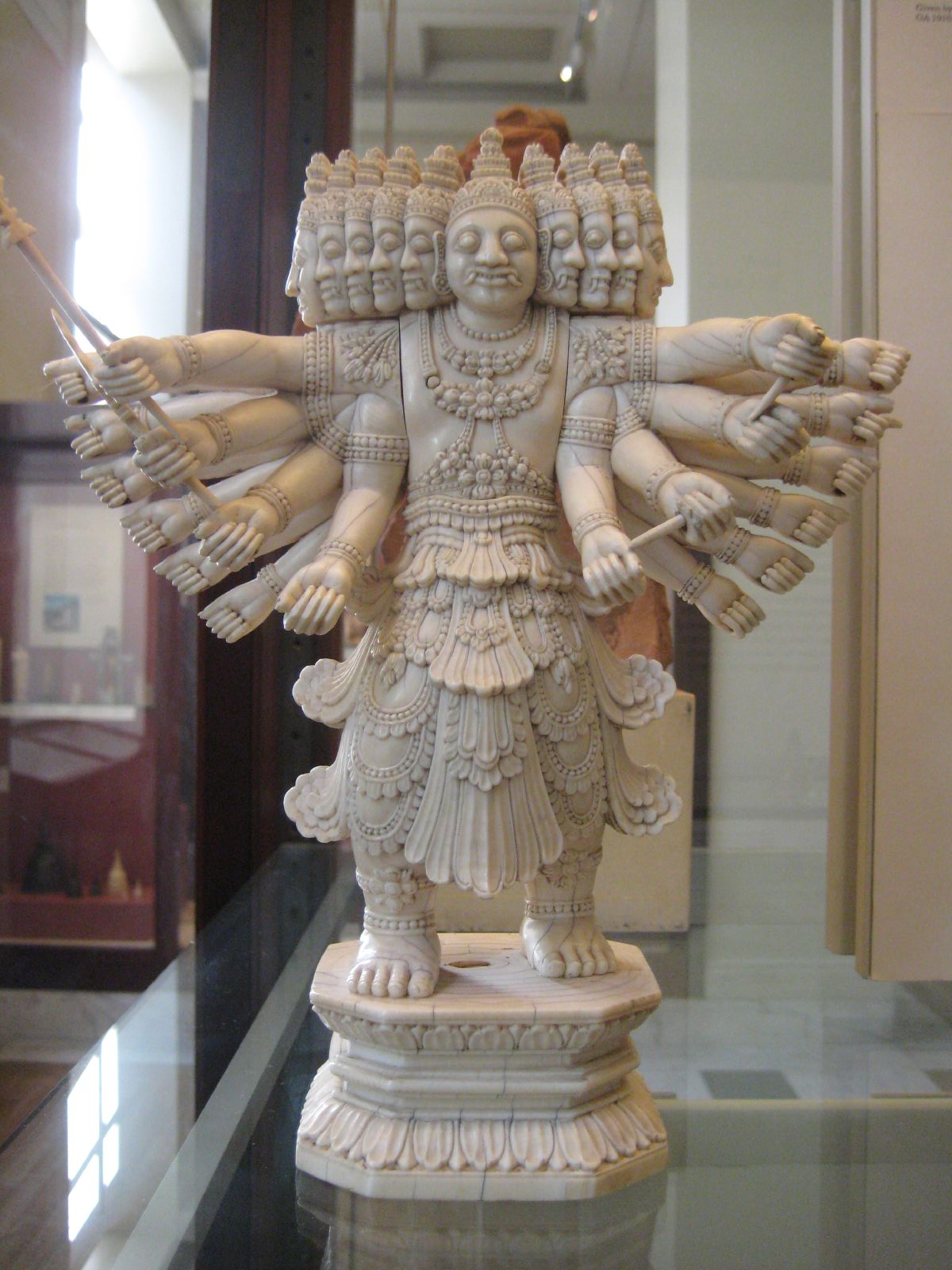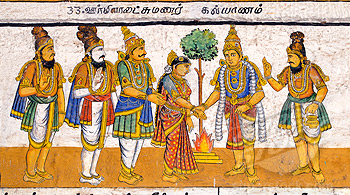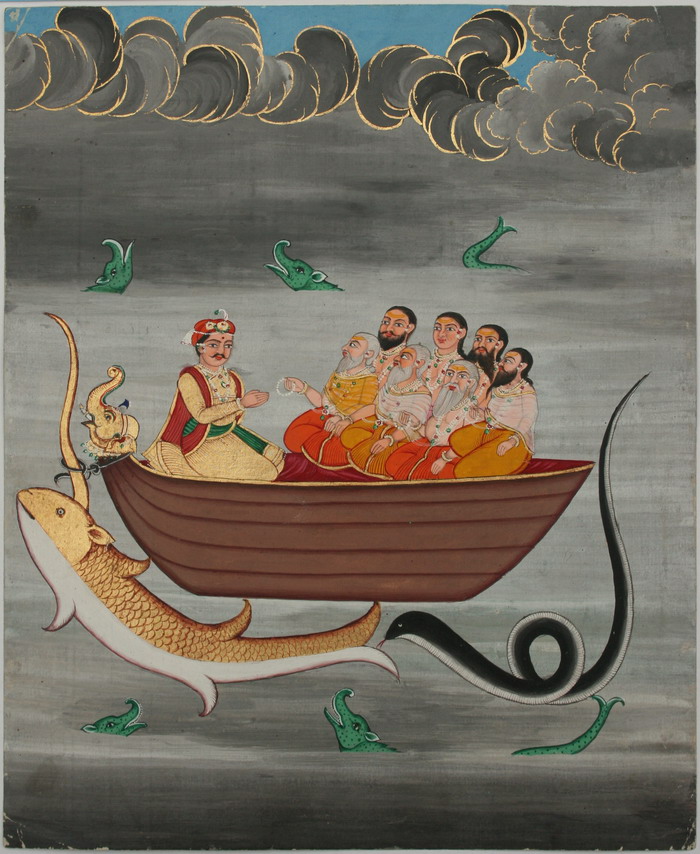|
Tataka
Tāṭakā is a minor ''yakṣī'' antagonist in the ''Rāmāyaṇa''. Along with her son, Mārīca, Tāṭakā would harass and attack sages performing yajñas in the forest. They were ultimately slain by Rāma and Lakṣmaṇa on behest of their teacher, Viśvāmitra Vishvamitra (, ) is one of the most venerated rishis or sages of ancient India. Vishvamitra is one of the seven Brahmarshi. According to Hindu tradition, he is stated to have written most of the Mandala 3 of the Rigveda, including the Gayatr .... ''Rāmāyaṇa'' In the ''Rāmāyaṇa'', Viśvāmitra tells Rāma and Lakṣmaṇa the story of Tāṭakā when they reach a forest inhabited by her. Viśvāmitra states that a yakṣa named Suketu had undertaken austerities to obtain children, and was given a daughter with the strength of a thousand elephants named Tāṭakā, but not a son. When she became of age, she was married to Sunda, and gave birth to a son named Mārīca. After Sunda is killed, Tāṭ ... [...More Info...] [...Related Items...] OR: [Wikipedia] [Google] [Baidu] |
Maricha
In the Hindu epic ''Ramayana'', Maricha, or Mareecha (Sanskrit: मारीच, IAST: ), is a rakshasha, who was killed by Rama, the hero of the epic and an avatar of Vishnu. He is mentioned as an ally of Ravana, the antagonist of the epic. His most notable exploit is his role in the kidnapping of Sita, Rama's wife. His son Kalanemi was killed by Hanuman. Cursed to be a rakshasa along with his mother Tataka and brother Subahu, Maricha initially led his life terrorizing sages. He was defeated by Rama at the behest of the sage Vishvamitra. He tried again to kill Rama, but had to run for his life again. Ultimately, Maricha assumed the form of a golden deer and helped Ravana kidnap Sita. Legend Early life Maricha was the son of the demon Sunda (son of Jamba or Jharjha) and a Yakshini named Tataka, also known as Taraka, Tadaka or Thataka. Tataka was the daughter of the yaksha king Suketu, who had gained her as a blessing from the god Brahma. Maricha also had a younger bro ... [...More Info...] [...Related Items...] OR: [Wikipedia] [Google] [Baidu] |
Suketu
''Ramayana'' is one of the two major Sanskrit ancient epics (''Itihasa''s) of Hindu literature. It was composed by sage Valmiki. This is a list of important figures that appear in the epic. A * Agastya: Rishi (sage). Son of sage Pulastya and brother of sage Vishrava. He was an uncle of Ravana. Agastya and his wife Lopamudra met Rama, Sita, and Lakshmana during their exile and gave them a divine bow and arrow. * Ahalya: Wife of the sage Gautama Maharishi. Many Hindu scriptures say that she was seduced by Indra (the king of the gods), cursed by her husband for infidelity, and liberated from the curse by Rama (an avatar of Vishnu). * Akampana: A a maternal uncle of Ravana. He was one of ten sons of Sumali and Ketumathi. He also had four sisters. He was one of the survivors of the battle between Khara and Dushana along with Shurpanakha. After escaping the deadly carnage, he instigated Ravana to kidnap Sita, thus indirectly making him one of the masterminds behind the war. L ... [...More Info...] [...Related Items...] OR: [Wikipedia] [Google] [Baidu] |
Ramayana
The ''Ramayana'' (; ), also known as ''Valmiki Ramayana'', as traditionally attributed to Valmiki, is a smriti text (also described as a Sanskrit literature, Sanskrit Indian epic poetry, epic) from ancient India, one of the two important epics of Hinduism known as the ''Itihasas'', the other being the ''Mahabharata''. The epic narrates the life of Rama, the seventh ''avatar'' of the Hindu deity Vishnu, who is a prince of Ayodhya (Ramayana), Ayodhya in the kingdom of Kosala. The epic follows Exile of Lord Rama, his fourteen-year exile to the forest urged by his father King Dasharatha, on the request of Rama's stepmother Kaikeyi; his travels across the forests in the Indian subcontinent with his wife Sita and brother Lakshmana; the kidnapping of Sita by Ravana, the king of Lanka, that resulted in bloodbath; and Rama's eventual return to Ayodhya (Ramayana), Ayodhya along with Sita to be crowned as a king amidst jubilation and celebration. Scholarly estimates for the earliest stage ... [...More Info...] [...Related Items...] OR: [Wikipedia] [Google] [Baidu] |
Rakshasa
Rākshasa (, , ; ; "preservers") are a race of usually malevolent beings prominently featured in Hinduism, Buddhism, Jainism and Folk Islam. They reside on Earth but possess supernatural powers, which they usually use for evil acts such as disrupting Vedic sacrifices or eating humans. The term is also used to describe asuras, a class of power-seeking beings that oppose the benevolent devas. They are often depicted as antagonists in Hindu scriptures, as well as in Buddhism and Jainism. The female form of rakshasa is rakshasi (). Hinduism In Puranas Brahmā, in a form composed of the quality of foulness, produced hunger, of whom anger was born: and the god put forth in darkness beings emaciate with hunger, of hideous aspects, and with long beards. Those beings hastened to the deity. Such of them as exclaimed, “Oh preserve us!” were thence called Rākṣasas. Those created beings, overwhelmed by hunger, attempted to seize the waters. Those among them who said, “ ... [...More Info...] [...Related Items...] OR: [Wikipedia] [Google] [Baidu] |
Lakshmana
Lakshmana (, ), also known as Laxmana, Lakhan, Saumitra, and Ramanuja, is the younger brother of Rama in the Hindu epic ''Ramayana''. He is considered as an incarnation of Shesha, the lord of serpents. Lakshmana was married to Urmila, and is known for his loyalty and dedication towards Rama. Lakshmana was born to King Dasharatha of Ayodhya and Queen Sumitra. Shatrughna, is his twin brother. He was married to Urmila, after his brother Rama married Sita in her swayamvara. Lakshmana devoted himself to Rama since childhood and accompanied him during his fourteen-year exile, serving him and Sita endlessly. He also played a pivotal role in the war and killed Meghanada. Lakshmana is worshipped in Hinduism, at various places in India, alongside Rama and Sita. Etymology The name Lakshmana is of Sanskrit origin, which means 'the one endowed with auspicious signs'. He bears the epithets of Saumitra (, ) and Ramanuja (, ). Legend Birth and early life King Dasharatha of A ... [...More Info...] [...Related Items...] OR: [Wikipedia] [Google] [Baidu] |
Vishwamitra
Vishvamitra (, ) is one of the most venerated rishis or sages of ancient India. Vishvamitra is one of the seven Brahmarshi. According to Hindu tradition, he is stated to have written most of the Mandala 3 of the Rigveda, including the Gayatri Mantra (3.62.10). The Puranas mention that only 24 rishis since antiquity have understood the whole meaning of —and thus wielded the whole power of — the Gayatri Mantra. Vishvamitra is supposed to have been the first, and Yajnavalkya the last. Before renouncing his kingdom and royal status, Brahmarishi Vishvamitra was a king, and thus he retained the title of Rajarshi, or 'royal sage'. Textual background Historically, Viśvāmitra Gāthina was a Rigvedic rishi who was the chief author of Mandala 3 of the Rigveda. Viśvāmitra was taught by Jamadagni Bhārgava. He was the purohita of the Bharata tribal king Sudās, until he was replaced by Vasiṣṭha. He aided the Bharatas in crossing the Vipāśa and Śutudrī rivers (mo ... [...More Info...] [...Related Items...] OR: [Wikipedia] [Google] [Baidu] |
Rakshasa In The Ramayana
Rākshasa (, , ; ; "preservers") are a race of usually malevolent beings prominently featured in Hinduism, Buddhism, Jainism and Folk Islam. They reside on Earth but possess supernatural powers, which they usually use for evil acts such as disrupting Vedic sacrifices or eating humans. The term is also used to describe asuras, a class of power-seeking beings that oppose the benevolent devas. They are often depicted as antagonists in Hindu scriptures, as well as in Buddhism and Jainism. The female form of rakshasa is rakshasi (). Hinduism In Puranas Brahmā, in a form composed of the quality of foulness, produced hunger, of whom anger was born: and the god put forth in darkness beings emaciate with hunger, of hideous aspects, and with long beards. Those beings hastened to the deity. Such of them as exclaimed, “Oh preserve us!” were thence called Rākṣasas. Those created beings, overwhelmed by hunger, attempted to seize the waters. Those among them who said, “w ... [...More Info...] [...Related Items...] OR: [Wikipedia] [Google] [Baidu] |
Female
An organism's sex is female ( symbol: ♀) if it produces the ovum (egg cell), the type of gamete (sex cell) that fuses with the male gamete (sperm cell) during sexual reproduction. A female has larger gametes than a male. Females and males are results of the anisogamous reproduction system, wherein gametes are of different sizes (unlike isogamy where they are the same size). The exact mechanism of female gamete evolution remains unknown. In species that have males and females, sex-determination may be based on either sex chromosomes, or environmental conditions. Most female mammals, including female humans, have two X chromosomes. Characteristics of organisms with a female sex vary between different species, having different female reproductive systems, with some species showing characteristics secondary to the reproductive system, as with mammary glands in mammals. In humans, the word ''female'' can also be used to refer to gender in the social sense of gen ... [...More Info...] [...Related Items...] OR: [Wikipedia] [Google] [Baidu] |
Rishis
In Indian religions, a ''rishi'' ( ) is an accomplished and enlightened person. They find mention in various Vedic texts. Rishis are believed to have composed hymns of the Vedas. The Post-Vedic tradition of Hinduism regards the rishis as "great yogis" or "sages" who after intense meditation ( tapas) realized the supreme truth and eternal knowledge, which they composed into hymns.Hartmut Scharfe (2002), Handbook of Oriental Studies, BRILL Academic, , pp. 13–15. The term appears in Pali literature as Ishi; in Buddhism they can be either Buddhas, Paccekabuddhas, Arahats or a monk of high rank. Etymology According to Indian tradition, the word may be derived from two different meanings of the root 'rsh' (). Sanskrit grammarians derive this word from the second meaning: "to go, to move". V. S. Apte gives this particular meaning and derivation, and Monier-Williams also gives the same, with some qualification. Another form of this root means "to flow, to move near by flowi ... [...More Info...] [...Related Items...] OR: [Wikipedia] [Google] [Baidu] |
Yajna
In Hinduism, ''Yajna'' or ''Yagna'' (, Help:IPA/Sanskrit, [jɐd͡ʒɲə], ) also known as Hawan, is a ritual done in front of a sacred fire, often with mantras. Yajna has been a Vedas, Vedic tradition, described in a layer of Vedic literature called Brahmanas, as well as Yajurveda. The tradition has evolved from offering oblations and libations into sacred fire to symbolic offerings in the presence of sacred fire (Agni). Yajna rituals-related texts have been called the ''Karma-kanda'' (ritual works) portion of the Vedic literature, in contrast to the ''Jnana-kanda'' (knowledge) portion found in the Vedic Upanishads. The proper completion of Yajna-like rituals was the focus of Mimansa school of Hindu philosophy. Yajna have continued to play a central role in a Hindu's rites of passage, such as weddings. Modern major Hindu temple ceremonies, Hindu community celebrations, or monastic initiations may also include Vedic Yajna rites, or alternatively be based on Āgama (Hinduism), A ... [...More Info...] [...Related Items...] OR: [Wikipedia] [Google] [Baidu] |
Rama
Rama (; , , ) is a major deity in Hinduism. He is worshipped as the seventh and one of the most popular avatars of Vishnu. In Rama-centric Hindu traditions, he is considered the Supreme Being. Also considered as the ideal man (''maryāda'' ''puruṣottama''), Rama is the male protagonist of the Hindu epic '' Ramayana''. His birth is celebrated every year on Rama Navami, which falls on the ninth day of the bright half ( Shukla Paksha) of the lunar cycle of Chaitra (March–April), the first month in the Hindu calendar. According to the ''Ramayana'', Rama was born to Dasaratha and his first wife Kausalya in Ayodhya, the capital of the Kingdom of Kosala. His siblings included Lakshmana, Bharata, and Shatrughna. He married Sita. Born in a royal family, Rama's life is described in the Hindu texts as one challenged by unexpected changes, such as an exile into impoverished and difficult circumstances, and challenges of ethical questions and moral dilemmas. The most not ... [...More Info...] [...Related Items...] OR: [Wikipedia] [Google] [Baidu] |
Rāma Slaying Tāṭakā
Rama (; , , ) is a major deity in Hinduism. He is worshipped as the seventh and one of the most popular avatars of Vishnu. In Rama-centric Hindu traditions, he is considered the Supreme Being. Also considered as the ideal man (''maryāda'' ''puruṣottama''), Rama is the male protagonist of the Hindu epic ''Ramayana''. His birth is celebrated every year on Rama Navami, which falls on the ninth day of the bright half (Shukla Paksha) of the lunar cycle of Chaitra (March–April), the first month in the Hindu calendar. According to the ''Ramayana'', Rama was born to Dasaratha and his first wife Kausalya in Ayodhya, the capital of the Kingdom of Kosala. His siblings included Lakshmana, Bharata, and Shatrughna. He married Sita. Born in a royal family, Rama's life is described in the Hindu texts as one challenged by unexpected changes, such as an exile into impoverished and difficult circumstances, and challenges of ethical questions and moral dilemmas. The most notable story i ... [...More Info...] [...Related Items...] OR: [Wikipedia] [Google] [Baidu] |









